
Wimpole Estate is a large estate containing Wimpole Hall, a country house located within the civil parish of Wimpole, Cambridgeshire, England, about 8+1⁄2 miles southwest of Cambridge. The house, begun in 1640, and its 3,000 acres (12 km2) of parkland and farmland are owned by the National Trust. The estate is regularly open to the public and received over 335,000 visitors in 2019. Wimpole is the largest house in Cambridgeshire.

Firbeck is a village and civil parish in the Metropolitan Borough of Rotherham in South Yorkshire, England, on the border with Nottinghamshire. It lies between Maltby and Oldcotes, off the A634 and B6463 roads. Firbeck had a population of 317 in 2001, which had fallen to 299 at the 2011 Census.

Papplewick is a village and civil parish in Nottinghamshire, England, 7.5 miles (12.1 km) north of Nottingham and 6 miles (9.7 km) south of Mansfield. It had a population of 756 at the 2011 census, and 651 at the 2021 census. In the Middle Ages, the village marked the southern gateway to Sherwood Forest.

Rufford Abbey is a country estate in Rufford, Nottinghamshire, England, two miles (4 km) south of Ollerton. Originally a Cistercian abbey, it was converted to a country house in the 16th century after King Henry VIII’s dissolution of the monasteries. Part of the house was demolished in the 20th century, but the remains, standing in 150 acres of park and woodland, are open to the public as Rufford Country Park. Part of the park is a local nature reserve.
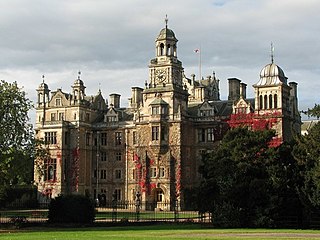
Thoresby Hall is a grade I listed 19th-century country house in Budby, Nottinghamshire, some 2 miles (4 km) north of Ollerton. It is one of four neighbouring country houses and estates in the Dukeries in north Nottinghamshire all occupied by dukes at one time during their history. The hall is constructed of rock-faced ashlar with ashlar dressings. It is built in four storeys with a square floor plan surrounding a central courtyard, nine bays wide and eight bays deep.
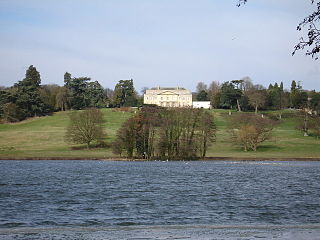
Gatton Park is a country estate set in parkland landscaped by Capability Brown and gardens by Henry Ernest Milner and Edward White at Gatton, near Reigate in Surrey, England.

Serlby Hall is a grade I listed 18th century mansion and estate in Nottinghamshire, England, located 7 miles north-east of Worksop.
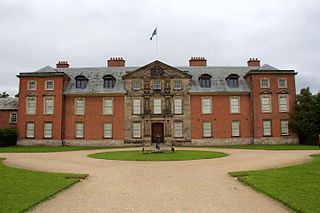
Dunham Massey Hall, usually known simply as Dunham Massey, is an English country house in the parish of Dunham Massey in the district of Trafford, near Altrincham, Greater Manchester. During World War I it was temporarily used as the Stamford Military Hospital.

The Manor of Clifton was a historic manor situated near the City of Nottingham, England. The manor house, known as Clifton Hall is situated on the right bank of the River Trent in the village of Clifton, Nottinghamshire,. about 3+1⁄2 miles south-west of the historic centre of the City of Nottingham, now partly the campus of Nottingham Trent University and partly a large council estate of modern housing.

Milton Hall near Peterborough, is the largest private house in Cambridgeshire, England. As part of the Soke of Peterborough, it was formerly in Northamptonshire. It dates from 1594, being the historical home of the Fitzwilliam family, and is situated in an extensive park in which some original oak trees from an earlier Tudor deer park survive. The house is a Grade I listed building; the garden is Grade II*.

Frederick Montagu was a British Whig MP.
Slebech was a community in Pembrokeshire, Wales, which is now part of the combined community of Uzmaston and Boulston and Slebech, a sparsely populated community on the northern shore of the Eastern River Cleddau. The community shares boundaries with the communities of Wiston and Llawhaden and mainly consists of farmland and woodland. Much of the community is within the Pembrokeshire Coast National Park and Picton Castle's stable block loft is an important breeding roost for the rare Greater Horseshoe Bat.

John Fountayne (1714–1802) was a Church of England clergyman and the longest serving Dean of York.

Wiverton Hall is an English country house near Tithby, Nottinghamshire in England. By 1510 the former village of Wyverton had become impoverished and reduced to just four houses and a cottage. It was in that year completely depopulated by "emparkment", when George Chaworth enlarged his park by 254 acres. All but the Grade II* listed gatehouse of the mansion was destroyed in the English Civil War. The current house dates from 1814. The location is also the centre of a wider civil parish with the same name, which had 41 residents at the 2021 census.

Rushton Hall in Rushton, Northamptonshire, England, was the ancestral home of the Tresham family from 1438, when William Tresham, a veteran of the Battle of Agincourt and Chancellor of the Duchy of Lancaster bought the estate. In the 20th century the house became a private school and it has now been converted to a luxury hotel. The estate is about 227 acres (92 ha) of which 30 acres (12 ha) are formal gardens. The River Ise flows from west to east south of the Hall.

Bunny Hall is a 21,438 square feet (1,991.7 m2) grade I listed country house in Bunny, Nottinghamshire.

Grimston Park is a grade II* listed Georgian country house in Grimston, North Yorkshire, England, some 1.7 miles (3 km) south of Tadcaster. Since being owned by the Fielden family, it has been converted into a number of luxury homes.
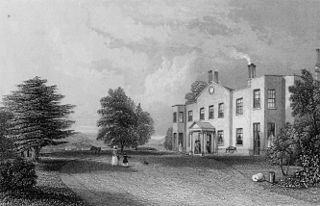
Denbies is a large estate to the northwest of Dorking in Surrey, England. A farmhouse and surrounding land originally owned by John Denby was purchased in 1734 by Jonathan Tyers, the proprietor of Vauxhall Gardens in London, and converted into a weekend retreat. The house he built appears to have been of little architectural significance, but the Gothic garden he developed in the grounds on the theme of death achieved some notoriety, despite being short-lived. The estate was bought by Lord King of Ockham following Tyers's death in 1767, and the macabre artefacts he had installed, including two stone coffins topped by human skulls, were removed.
Charles Montagu, of Papplewick, Nottinghamshire. was a British landowner and politician who sat in the House of Commons between 1722 and 1759.
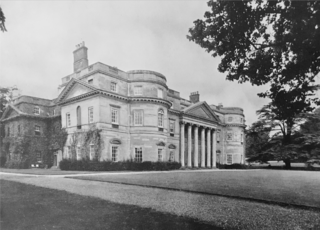
Horton Hall, known locally as Horton House, was a stone-built Georgian stately home, now demolished, located on a 3,764 acre estate stretching across nine parishes on the Northamptonshire and Buckinghamshire borders.



















